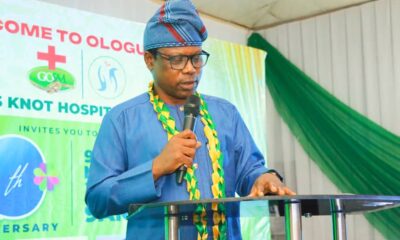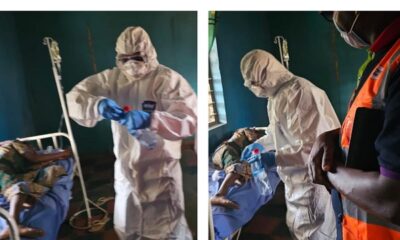Health
Everything You Need to Know About Bipolar Disorder
What is bipolar disorder?
Bipolar disorder is a mental health condition marked by extreme shifts in mood.
Key symptoms include:
episodes of mania, or an extremely elevated mood
episodes of depression, or a low mood
Older terms for bipolar disorder include manic depression and bipolar disease.
Bipolar disorder isn’t a rare condition. In fact, the National Institute of Mental HealthTrusted Source says that 2.8 percent of U.S. adults — or about 5 million people — have a bipolar disorder diagnosis.
Although bipolar disorder doesn’t have a cure, many effective treatments are available. These treatment options can help you learn to manage mood episodes, which can improve not only your symptoms, but also your overall quality of life.
Types of bipolar disorder
There are three main types of bipolar disorder: bipolar I, bipolar II, and cyclothymia.
Bipolar I
Bipolar I is defined by the appearance of at least one manic episode. You may experience hypomanic episodes, which are less severe than manic episodes, or major depressive episodes before and after the manic episode. This type of bipolar disorder affects people of all sexes equally.
Bipolar II
People with bipolar II experience one major depressive episode that lasts at least 2 weeks. They also have at least 1 hypomanic episode that lasts about 4 days. According to a 2017 reviewTrusted Source, this type of bipolar disorder may be more common in women.
Cyclothymia
People with cyclothymia have episodes of hypomania and depression. These episodes involve symptoms that are shorter and less severe than the mania and depression caused by bipolar I or bipolar II disorder. Most people with this condition only experience no mood symptoms for 1 or 2 months at a time.
Your doctor can explain more about what kind of bipolar disorder you have when discussing your diagnosis.
Some people experience distinct mood symptoms that resemble but don’t quite align with these three types. If that’s the case for you, you might get a diagnosis of:
other specified bipolar and related disorders
unspecified bipolar and related disorders
Learn more about the types of bipolar disorder.
ADVERTISEMENT
Traditional therapy – done online
Choose from BetterHelp’s network of therapists for your disorder symptoms and stay supported by phone, video, or live chat sessions. Plans start at $60 per week + an additional 20% off your first month.
Bipolar disorder symptoms
To receive a diagnosis of bipolar disorder, you must experience at least one period of mania or hypomania.
These both involve feelings of excitement, impulsivity, and high energy, but hypomania is considered less severe than mania. Mania symptoms can affect your day-to-day life, leading to problems at work or home. Hypomania symptoms typically don’t.
Some people with bipolar disorder also experience major depressive episodes, or “down” moods.
These three main symptoms — mania, hypomania, and depression — are the main features of bipolar disorder. Different types of bipolar disorder involve different combinations of these symptoms.
Bipolar I symptoms
A diagnosis of bipolar I disorder requires:
at least 1 episode of mania that lasts at least 1 week
symptoms that affect daily function
symptoms that don’t relate to another medical or mental health condition or substance use
You could also experience symptoms of psychosis, or both mania and depression (known as mixed features). These symptoms can have more impact on your life. If you do have them, it’s worth reaching out for professional support as soon as possible (more on this later).
While you don’t need to experience episodes of hypomania or depression to receive a bipolar I diagnosis, many people with bipolar I do report these symptoms.
Bipolar II symptoms
A diagnosis of bipolar II requires:
at least 1 episode of hypomania that lasts 4 days or longer and involves 3 or more symptoms of hypomania
hypomania-related changes in mood and usual function that others can notice, though these may not necessarily affect your daily life
at least 1 episode of major depression that lasts 2 weeks or longer
at least 1 episode of major depression, involving 5 or more key depression symptoms that have a significant impact on your day-to-day life
symptoms that don’t relate to another medical or mental health condition or substance use
Bipolar II can also involve symptoms of psychosis, but only during an episode of depression. You could also experience mixed mood episodes, which means you’ll have symptoms of depression and hypomania at the same time.
With bipolar II, though, you won’t experience mania. If you have a manic episode, you’ll receive a diagnosis of bipolar I.
Cyclothymia symptoms
A diagnosis of cyclothymia requires:
periods of hypomanic symptoms and periods of depression symptoms, off and on, over 2 years or longer (1 year for children and adolescents)
symptoms that never meet full criteria for an episode of hypomania or depression
symptoms that are present for at least half of the 2 years and never absent for longer than 2 months at a time
symptoms that don’t relate to another medical or mental health condition or substance use
symptoms that cause significant distress and affect daily life
Fluctuating mood symptoms characterize cyclothymia. These symptoms may be less severe than those of bipolar I or II. Still, they tend to last longer, so you’ll generally have less time when you experience no symptoms.
Hypomania may not have a big impact on your daily life. Depression, on the other hand, often leads to more serious distress and affects day-to-day function, even if your symptoms don’t qualify for a major depressive episode.
If you do ever experience enough symptoms to meet the criteria for a hypomanic or depressive episode, your diagnosis will likely change to another type of bipolar disorder or major depression, depending on your symptoms.
Health
Oyo: Tragedy As Bride-to-Be Among Four Dead in Suspected Lassa Fever Outbreak
The Oyo State Ministry of Health has closed two hospitals in Saki West Local Government Area following a suspected outbreak of Lassa fever, which has claimed four lives.
The fatalities, confirmed by the Oyo State Rapid Response Team (RRT), include three males and a 32-year-old female who was preparing for her wedding. The closure of the hospitals aims to contain the spread of the disease and ensure thorough decontamination.
In a press statement issued by the Commissioner for Information and Orientation, Dotun Oyelade, the State Commissioner for Health, Dr. Oluwaserimi Ajetunmobi, revealed that the RRT was dispatched to Saki following distress calls from residents reporting mysterious deaths.
Findings and Immediate Actions
The RRT, comprising health officials, representatives from WHO and the Red Cross, and local health authorities, conducted a comprehensive investigation into the outbreak.
Preliminary findings suggest that an apprentice at one of the affected hospitals, who had recently returned from Iwajowa Local Government Area, might have introduced the infection.
The team disclosed that the deceased exhibited symptoms consistent with Lassa fever, such as craniofacial bleeding. The hospital owner, who was among the deceased, initially self-medicated with antimalarials and antibiotics before seeking hospital care when his condition worsened.
Containment Measures
Both the hospital where the fatalities occurred and the facility that admitted the hospital owner were shut down for decontamination.
Contact tracing efforts are ongoing, focusing on high-risk individuals who had contact with the deceased during their illness or burial.
Affected health workers were trained on Infection Prevention and Control (IPC) protocols, and public awareness campaigns were conducted to educate residents about Lassa fever.
Samples have been collected from a symptomatic individual, pending laboratory confirmation. Line-listing of contacts is underway to identify potential cases and prevent further spread.
Collaborative Efforts
The RRT also paid an advocacy visit to the Okere of Saki’s palace to brief traditional authorities on the situation. Local government officials in Saki West were engaged to coordinate containment strategies.
Reports indicate that while the outbreak initially affected Saki West, it has extended to Iwajowa and Kajola Local Government Areas.
Disease Surveillance and Notification Officers (DSNOs) in the affected LGAs have been instructed to commence preliminary containment measures as the State RRT ramps up its response.
Call for Vigilance
The Ministry of Health has urged residents to remain vigilant, report any symptoms suggestive of Lassa fever, and adhere to preventive measures.
These include proper hygiene practices, avoiding contact with rodents, and seeking medical attention promptly if symptoms arise.
Health
Oyo: Oseni to Launch Mobile Clinic Initiative to Revitalize Rural Healthcare
A member representing Ibarapa East/Ido federal constituency of Oyo State at the House of Representatives, Engr. Aderemi Oseni, has announced a plan to launch a “Mobile Clinic” programme aimed at providing essential healthcare services directly to rural communities across the constituency.
Scheduled to begin in the first quarter of 2025, this initiative underscores Oseni’s commitment to expanding healthcare access, particularly for underserved populations.
Speaking on Saturday at the 10th-anniversary celebration of God’s Knot Hospital in Ologuneru, Ibadan, the lawmaker, who also chairs the House Committee on the Federal Roads Maintenance Agency (FERMA), highlighted the programme’s primary objective: bringing healthcare closer to the people.
“Every community deserves attention; healthcare should never be bound by geographical barriers,” Oseni stated.
He explained that the mobile clinics would deliver essential health check-ups, screenings, and preventive care in remote areas, allowing residents to access quality healthcare without traveling long distances.
As part of his broader healthcare agenda, Oseni informed, through a statement by his media aide, Idowu Ayodele, that he has already facilitated the construction of two fully equipped maternity centers within his constituency, both slated for commissioning before December 2024. He also disclosed plans to establish two modern general hospitals in 2025, further strengthening his commitment to building a healthier community.
The lawmaker expressed interest in collaborating with God’s Knot Hospital on the mobile clinic project, calling for partnerships to support sustainable healthcare initiatives that enhance the quality of life for vulnerable populations in the constituency.
“I resonate deeply with the mission of God’s Knot Hospital,” Oseni shared, adding that such partnerships would significantly improve healthcare in Oyo State”.
The anniversary event attracted distinguished guests, including former Ondo State Governor Dr. Olusegun Mimiko, whom Oseni commended for his contributions to healthcare, particularly through the Mother and Child Hospitals that transformed maternal and child healthcare in Ondo State.
Oseni urged philanthropists, government bodies, and international organizations to support healthcare projects like the upcoming mobile clinics, emphasising that the improvement of healthcare services is a shared responsibility.
Health
NAFDAC Shuts Maiduguri Market Over Sun-Dried Drugs After Flood
The National Agency for Food and Drug Administration and Control (NAFDAC) has ordered the immediate closure of the Gomboru drug market in Maiduguri following severe flooding that submerged the area and contaminated the drugs sold within the market.
In a statement posted on its official X handle, NAFDAC disclosed that the decision was made after reports surfaced that contaminated drugs, which had been washed and sun-dried for resale, were being sold at the market.
“After the recent flooding in Maiduguri that submerged the Gomboru drug market where contaminated drugs were washed and sun-dried for resale, the @DGatNAFDAC ordered the immediate closure of the market to conduct a thorough shop-to-shop removal of these compromised drugs,” the agency wrote.
The flooding, which ravaged Maiduguri, was triggered by the rupture of the Alau dam on the Ngadda River, located 20 kilometers (12 miles) south of the city.
The floodwaters claimed at least 30 lives and displaced 400,000 residents, leaving large parts of the city and surrounding areas in devastation.
NAFDAC’s intervention is aimed at safeguarding public health by preventing the sale and consumption of contaminated drugs.
The agency has mobilized teams to inspect the market and ensure the removal of all compromised pharmaceutical products.
-



 Politics2 days ago
Politics2 days agoOyo Rep. Member, Akinmoyede Appoints Three More Aides
-



 Health1 week ago
Health1 week agoOyo: Oseni to Launch Mobile Clinic Initiative to Revitalize Rural Healthcare
-



 Crime & Court5 days ago
Crime & Court5 days agoEFCC Chair Raises Alarm on Rampant Fraud in Nigeria’s Electricity Sector
-



 Health3 days ago
Health3 days agoOyo: Tragedy As Bride-to-Be Among Four Dead in Suspected Lassa Fever Outbreak